AND WE ALL FALL DOWN - TRUE STORIES OF A TRUE GHOST TOWN
The Rise and Fall
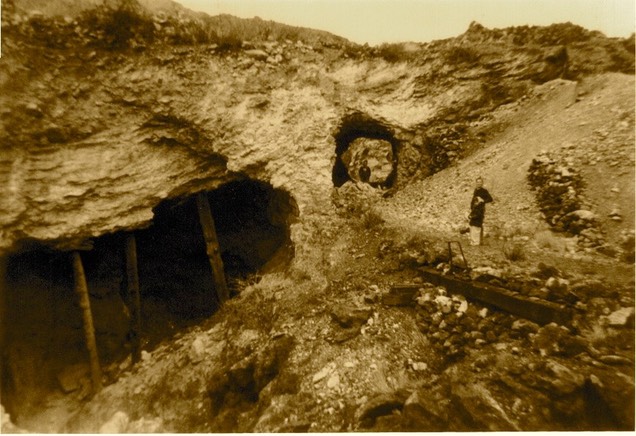
Many of the towns in the Black Range were one-ore towns. Generally, it was gold or silver. In the case of Lake Valley, it was silver. In the early 1870’s Lake Valley was nothing more than a stage stop known by various names; Sierra City, Daly, and Lake City. In 1878 silver was discovered in the area and a Post Office was established - which required an official name - Lake Valley. In 1882 the fabled Bridal Chamber (photo below) was discovered, an

incredibly rich strike with the walls of the chamber coated in native silver (entrance shown here). Lake Valley moved to its current location at that time. In 1882, only months after the chamber was discovered, a piece of silver weighing close to 440 pounds was mined from the Bridal Chamber and exhibited at the World Exposition in Denver. At today’s silver prices that piece of silver was worth about $275,000. There are claims that more than 2,500,000 ounces of silver was mined from the Bridal Chamber - note, however, that some sources quote production at $2,775,000 - dollars, not ounces.) The photograph below is of downtown Lake Valley in about 1880.
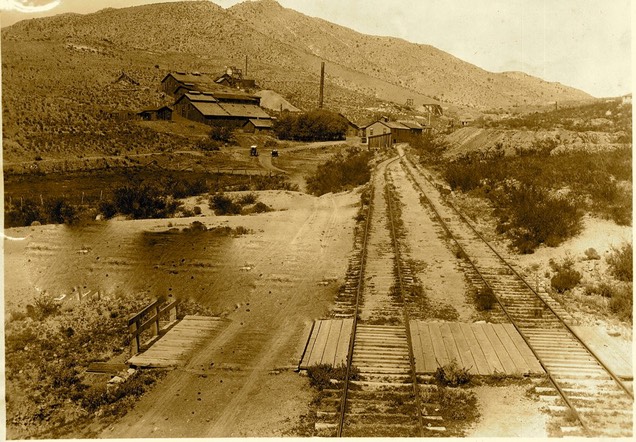


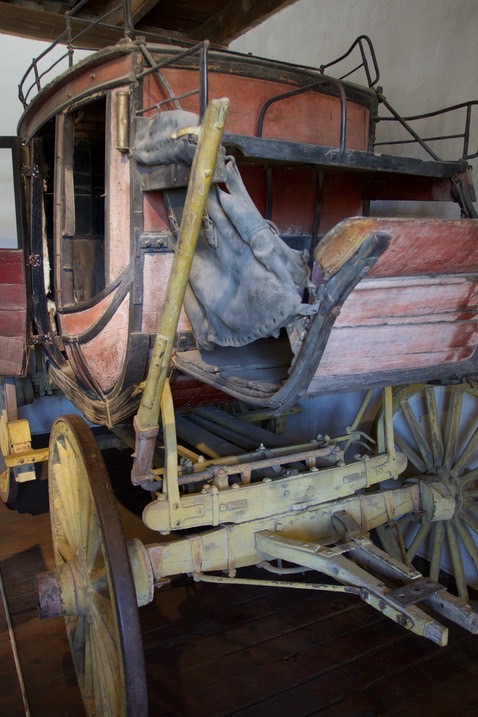

Cope et al.
Mining in the west has a nasty reputation. That reputation was well deserved in the case of Lake Valley. The mines at Lake Valley were owned by the Sierra Grande Mining Company. Whitaker Wright established the holding company and increased his wealth immensely by selling $5 million shares in his company all over the world. It is reported that the Sierra Grande Company was paying out $100,000 a month in dividends at this time. His business practices were based on misleading and often fraudulent information. He died a rather dramatic death, taking cyanide in a London courtroom rather than going to prison for fraud.
Good can be in the eye of the beholder, and sometimes “good” comes from dastardly deeds. Starting in the 1860’s, the great bone war broke out between Edward Drinker Cope (photo left taken prior to 1897) and Othniel Charles Marsh. Cope is one of America’s great paleontologists and a person who kept one of the largest private collections of fossils at the time, Marsh who had the support of John W. Powell was another of America’s great paleontologists. The competition between the two became bitter and expensive and grew to include their major sponsors. To continue his collecting, Cope sought to augment his personal fortune by purchasing a lot of stock in the Lake Valley mines. the mines played out in 1883. In 1886 he had to sell his worthless stock, and in 1895 he sold his priceless set of mammal fossils from the west (over 10,000 specimens) to the American Museum of Natural History for $32,000. Cope’s travails and hardships became the American public’s gain.
The Transport Side of Sadie Orchard
By 1884 the mining operations at Lake Valley were so lucrative that a Santa Fe railroad spur was built north from Nutt. This rail line was not abandoned until 1934. The old rail bed is visible on the east side of town. The photograph of a train tracks are shown to the left.

The photo, below left, of a train just south of Lake Valley dates from about 1900. (Lizard Rock of Monument Peak can be seen in the background.
The stage coach line which ran from Lake Valley to Hillsboro and on to Kingston was an important economic and cultural lifeline for the communities. This type of short-haul stagecoach operation was typical of the west as railroads took over the “trunk lines”. Passengers, mail, and freight would be picked up at the railhead and transported to towns not on the rail line. Stagecoach service was available in the area at least as early as 1883.
The photograph of a “Mountain Pride” stagecoach (photo below left) of the Kingston Stage Line was taken in front of the Miller Drug Store in Hillsboro by George T. Miller between 1905 and 1908. This line was operated between 1888 and 1902 by Sadie Orchard and her husband. She apparently drove the stagecoach on occasion. In addition to an express wagon, the line used two Concord stagecoaches. The Concord is the stage which Samuel Clemens described as “a cradle on wheels” in Roughing It. Four changes of horses were required for a trip from Lake Valley to Kingston. In all the line used 60 horses to keep its operation going. For more on the topic of “stage- coaching” you may wish to read “Stage- coaching in Territorial New Mexico” by William S. Wallace in Volume 32 of the New Mexico Historical Review, p. 204. See also “Short-Line Staging in New Mexico” by the same author in Volume 26 of the New Mexico Historical Review, p. 89.
The Mountain Pride is currently on display in the Hillsboro Historical Museum, Hillsboro, New Mexico. The photograph, below left, was taken at the Lincoln Historic Site in Lincoln, New Mexico when the stage was exhibited there.
In 1902 the Mister family purchased the stage coach line which operated between Lake Valley and Kingston (via Hillsboro) from the Orchard’s. The Misters stopped operating the line in 1916 and on January 7, 1918, Frederick W. Mister and his wife Nancy sold their stage line to William D. Slease.
Sadie Creech Orchard, who died in Hillsboro in 1943, would have noted the transaction. She was at the time, and probably still is, one of the Black Range’s more notorious characters. Born in either Iowa or London - take your pick - she was involved in a number of businesses in Lake Valley - Hillsboro - Kingston. As she noted in an October 23, 1936 interview with Clay W. Vaden (who was working for the WPA Writers’ Project), “Mr. Orchard and I drove the stage line for 14 years. We had two Concord coaches and an express wagon....”
Mr. Mister was also part of the Black Range business establishment, he owned part of a mercantile business in Kingston before moving to Hillsboro in 1900 to open a meat market.
During the time that the Orchards and Misters owned the stage line people, mail, and freight would have traveled to Nutt and then Lake Valley by train before being off loaded to the stage coaches. Leaving Lake Valley the coach would travel north for about six miles before changing horse teams at Harlosa Springs Station. Twelve miles farther on the stage reached Hillsboro. From Hillsboro the coach which followed Percha Creek up to Kingston, sometimes in the stream bed sometimes on the banks above. (Map from New Mexico Historical Review, Vol. XXVI, No. 2, 1951, “Short-line Staging in New Mexico” By William Swilling Wallace.)
The transfer points for passengers were the railroad depot in Lake Valley, the Union Hotel in Hillsboro, and the Mountain Pride Hotel in Kingston (after which the Concord stage coach operated by the line was named).
The horses were always fresh and the journey was relatively fast. For instance, leaving Lake Valley at noon the stage would arrive in Hillsboro at 3:00 p.m.. It would depart Hillsboro at 3:10 and arrive in Kingston at 4:40 p.m.. The trip from Kingston left at 6:30 p.m. arriving in Hillsboro at 8:30 p.m. where the coach overnighted. Leaving Hillsboro at 7:00 a.m. the next morning the coach arrived in Lake Valley at 10:00 a.m.
Passenger fares on the stage coach were: Lake Valley to Hillsboro $2 one-way or $3.50 round-trip; from Hillsboro to Kingston $1.50 and $2.50; and from Lake Valley to Kingston $3.25 and $5.50.
A Concord Coach had a normal capacity of 9, which included seating on the top. Sometimes more were carried. On the last day of the Fountain murder trial 23 participants of the trial, including Pat Garrett, boarded a special coach back to Lake Valley. The photo to the left, taken in Lake Valley shortly after the sale to the line to Slease, is of the Mountain Pride and shows just how overload a coach with 23 passengers (plus baggage) would have been. The photo was taken at about the time Arthur Seligman purchased the Mountain Pride. (The Mountain Pride was given to the Museum of the Palace of the Governors in Santa Fe when Arthur Seligman died. Arthur Seligman Scott writes about the coach in “Seligman Stage Coaches Revisited”.)
The photo to the left is of the Mountain Pride near Harlosa Springs station, circa 1900, from the Lake Valley School Museum collection.
By the time that Mister sold the stage line, automobiles and trucks were (or had already) replaced the stage coach as a foundation for the business. On January 7, 1918 Mister sold the stage line to William D. Slease. The following is from the Bill of Sale of that transaction. It seems to have been “traditional” at the time to list the purchase price of all sorts of things as $1. This Bill of Sale is no different. For “$1” Mr. Slease bought (all language, spelling, and punctuation as in the original unless so noted):
“The Automobile and Stage Line Outfit, running between the towns of Nutt, Lake Valley, Hillsboro, and Kingston ...consisting of one “Chandler” seven passenger auto-mobile...and one “Dodge” five passenger automobile...two “Ford” five passenger automobiles...one “Smith-Ford” Ford truck...one bay horse named “Deek”...one bay horse named “Jim”...one gray horse named “Willie”...one black horse called “Raven”...one gray horse called “Alex”....(and several more all with the brand information)...Also four buggies, two hacks, one Concord Coach (probably the Mountain Pride)...(various bits of tackle and office equipment)...the building and corrals at Lake Valley, New Mexico consisting of one adobe building, corrals, stables, and sheds, one frame building all situate near the Railroad Depot in Lake Valley N.M. also about two tons of oats at Lake Valley...two underground metal gas tanks at Hillsboro, N.M. and about 250 gallons gasoline..(various fixtures and auto supplies)...intending to convey any and all property not herein enumerated, and used in connection with said Automobile and Stage Line outfit, and business…”
And so ended stage coaching in the Black Range.
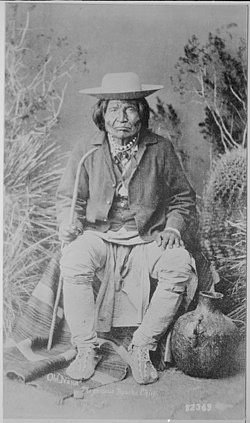
Nana and Woods
The atrocities committed by Indians, Anglos, and Hispanic/Mexicans during the Indian Wars of the American west are myriad. All of the groups murdered unarmed men, women, and children. Bodies were mutilated. Homes were burned. Innocents were kidnapped, women were raped, captives were enslaved. Terrible savagery on all sides. It is not as simple as the Native Americans fighting to maintain their homeland or that the Anglos and Hispanic/Mexicans had rights by conquest. This was a clash of cultures on a major scale. Different value systems allowed all to believe that they had the right to do what they were doing.
If we can put aside the value judgments we make about these atrocities it is possible to dredge up tidbits of something noteworthy, something more than humans acting like humans. Such are the cases of Nana and Sergeant Brent Woods.
Nana (photo left from 1886)is described at times as a sub-chief or sometimes just as a leader of a band of Indians, mostly from the Chihenne band of the Chiricahua Apache. The Chihenne claimed the area around Ojo Caliente or Warm Springs and are sometimes called the Warm Springs Apaches as a result. Warm Springs was located just north of the Black Range and just south of the San Mateo Mountains. The springs are the headwaters of Alamosa Creek. Follow the Ojo Caliente link to see our video of this site.

A leader of the Chihenne, Victorio (photo below left from the National Archives is possibly Victorio from about 1880), was a strongly religious man who believed that Ussen, the supreme diety of the Apache religion had created the Chihenne at Warm Springs and had directed them to take care of the springs. The people of the United States believed otherwise, their religious vision of manifest destiny was the basis for their land claims in western America, including Warm Springs. In 1871 the US Government decided to move the Chihenne from Warm Springs to Tularosa about fifty miles to the west and during the summer of 1872 they did so.
Instead of relocating to the Tularosa reservation, Victorio and a number of his band sought refuge in the Black Range. After a series of negotiations, misunderstandings (or misrepresentations), a resolution was finally reached in 1874 when a reservations was established at Warm Springs.
In 1877, the US Government decided to establish a reservation at San Carlos, Arizona and move all of the Apache bands to that location. After a few months, Victorio and a number of his men fled the reservation, only to surrender at Fort Wingate in New Mexico. At that time the Victorio group was relocated to Warm Springs. The situation was uncertain, the US Government did not seem capable of deciding what it was going to do with the band. After two years of uncertainty and fearing that they would be returned to San Carlos, Victorio and his followers declared war.
Just prior to the outbreak of overt warfare, Victorio went to the Mescalero Apache reservation at Sierra Blanca and enlisted the help of Nana who was married to his sister. Nana had led his group of Chihenne to Sierra Blanca, trying to stay out of the uncertainty at Warm Springs.
Victorio was a very skillful fighter and inspirational leader. The US Army considered him the greatest of all the Indian leaders which they faced. When he declared war, Victorio took his warrior band into the Black Range, territory that they knew well, and made war on the vastly more numerous US Army. The Black Range is rugged country, hard on people and hard on horses. When the Indian warriors needed fresh horses they would raid a nearby ranch and take fresh ones. The US Army had no such flexibility, without fresh horses and in rugged country that they knew poorly they were at a disadvantage, despite their superior numbers. The mountains were perfect for the guerrilla tactics used by the Indian forces and when they were pressed to hard they could flee across the international border with Mexico - knowing that coordination between the US and Mexican forces was non-existent.
In the United States, the main forces in opposition to Victorio’s group were the Buffalo Soldiers of the 9th and 10th Cavalry. These cavalry units were seasoned troops who generally enjoyed high morale. They were assigned some of the worst duty in the west but, in general, the Army treated these black soldiers better than blacks were treated in society at large. As a result, their reenlistment rates were high and their desertion rates were low - resulting in battle tested soldiers who were experienced in the southwest of the United States. Pay averaged $19 a month.
“Victorio’s War” ended on October 14, 1880. On the night of the 13th, a Mexican Army unit under the command of Col. Joaquín Terrazas attacked Victorio’s band at Tres Castillos. Victorio and most of the warriors (approximately 80) in his group were killed that night and during the next day. Sixty-eight children and women were captured and sold into slavery. (There are claims that Victorio took his own life rather than surrender.)

Nana and his followers were not present at Tres Castillos. Following Victorio’s death, Nana fled into the Sierra Madre of Mexico. Seeking revenge, Nana led his followers back into the United States and conducted “Nana’s Raid.” Part of that raid occurred on August 17, 1881 when he and his band burned the ranch of Absolom Irwin in the Berrenda Creek area not far from Lake Valley. (See Volume 9, Number 4, of Guajalotes, Zopilotes, y Paisanos - the newsletter of the Hillsboro Historical Society.)
George Daly, the mining superintendent at what is now Lake Valley, a number of miners from Lake Valley, and a detachment of Buffalo Soldiers (Companies B & H of the 9th Calvary) under the command of Lieutenant George Washington Smith went in pursuit of Nana’s band. On August 19, about ten miles west of Lake Valley, the Americans were ambushed in Gavilan Canyon. Daly, Smith, a least four soldiers, and several miners were killed. When Smith was killed, Sergeant Brent Woods (photo left) took charge of his unit and eventually led the Anglo force to safety despite being wounded in the arm. For his actions in the six-hour battle, Woods would later become one of 18 Black Americans to receive the Congressional Medal of Honor during the Indian Wars. (See also A Tale of Two Canyons by Mark B. Thompson, III on the Hillsboro Historical Society Blog Site.)

There was a lot going on in the area at that time. For action only a few days earlier at the Battle of Fort Tularosa, New Mexico, other Buffalo Soldiers also received the Congressional Medal of Honor - Sergeant George Jordan, Sergeant Thomas Shaw, Private Augustus Walley, and First Sergeant Moses Williams. Of the 426 Congressional Medal of Honor medals award for action in the Indian Campaigns, 18 were awarded to black men, 14 were Buffalo Soldiers and 4 were US Army Scouts from the Seminole Tribe. Eight of the Medals of Honor awarded to black men during the Indian Wars were awarded to Buffalo Soldiers of the 9th Calvary for action in southwestern New Mexico.
These two remarkable men, Nana and Woods met in a canyon in the Black Range and both walked away alive. What we know about each enriches the story immensely.
Brent Woods was born in Pulaski County, Kentucky in 1855 and spent the first ten years of his life as a slave. At age 18 he enlisted in the US Army at Jefferson Barracks in Missouri and was assigned to Company B of the 9th Calvary as a private. His first reenlistment was at Fort Bayard, New Mexico (or perhaps Fort Hayes, Kansas). In 1883 he reenlisted for this third tour at Louisville, Kentucky as a Sergeant in Company B of the 9th Calvary. He was discharged on November 7, 1888 at Fort Robinson, Nebraska. He reenlisted about a month later (December 4) at Cincinnati, Ohio and was assigned to the 10th Calvary as a private. He was discharged on the 3rd of December of 1893 at Fort Assinniborn, Montana. Three days later, he reenlisted in Chicago, Illinois and was assigned to Company C of the 9th Calvary as a Sergeant. He was discharged on December 5, 1898 at Fort Huachuca, Arizona. His last enlistment started on the 6th of December of 1901 when he was assigned to Company M of the 9th Calvary. He retired about a year later (November 22, 1902) at the Presido of San Francisco, California.
On August 19, 1881 when Woods was at Gavilan Canyon he was serving his first tour of duty and was 26 years old. When the Medal of Honor was finally issued to him on July 12, 1894 (it was not uncommon for there to be long delays in the processing of these medals at this time in history) he was on his second tour of duty.
He was buried near his home in Kentucky. His burial site was later moved to Mill Springs National Cemetery, Nancy, Kentucky (Grave in Section A, No 930). His Medal of Honor was maintained at the Cemetery Visitor Center until 2004 when it was stolen. The US Army replaced the Medal in 2008.
Nana was in his seventies, perhaps eighties, when he and Woods “met” at Gavilan Canyon. His legs were partially disabled and he was short, he was the opposite of Woods in physique.
The following material was used in compiling this section:
- Wikipedia entry dated March 16, 2013 entitled List of African-American Medal of Honor Recipients
- The website of the Congressional Medal of Honor Society, 40 Patriots Point Rd., Mt. Pleasant, S.C. 29464
- “Civil War Hero from Pulaski to be Honored” 2/12/2008 - Commonwealth Journal
- “Most Wanted”: Stolen Medals” 2/16/2007 Air Force Times
- “A Day for Remembering - Medal of Honor for Soldier In Indian Wars Displayed” 2/17/2008 - Commonwealth Journal
- The Buffalo Soldiers: A Narrative of the Black Cavalry in the West by William H. Leckie, University of Oklahoma Press, May 30, 2007, pp. 237 and 259
- “Victorio’s War”, originally published in the Wild West Magazine, published on-line September 3, 2008 at Historynet.com (www.historynet.com).
- “Warm Springs Apache Leader Nana: The 80-Year-Old Warrior Turned The Tables”, originally published in the Wild West Magazine, published on-line October 18, 2006 at Historynet.com (www.historynet.com).
- Wikipedia entry dated Jan. 12, 2013 on Brent Woods
- www.togetherweserved.com -- March 19, 2013
- The Woods & Wanton Chapter, Inc. of the “Buffalo Soldiers” webpage on Sgt. Brent Woods, accessed March 19, 2013

Cattle Rustling and Albert Fountain
Lake Valley developed a reputation as a cattle rustling center early on in its history. In 1883, the Territorial Governor instructed the Territorial Militia to address the cattle rustling problem. (See the February 16 and 2/23/1883 issues of The black Range Newspaper for “real-time reporting” of this event.) On March 22, 1883, Major Albert Fountain (photo left), commanding the First Regiment of the Territorial Militia out of Las Cruces, surrounded Lake Valley in the wee hours of the morning. Fountain arrested two and left town at about 4 AM. Shortly after that, Fountain claims that the two tried to escape and were killed. A protest arose in Lake Valley, and the Sierra Grande Mining Company arrested the protest leader and one other man. Fountain’s militia returned to Lake Valley the next afternoon and took charge of the prisoners. A few hours later, the protest leader was killed “while trying to escape.” In 1896, Fountain and his son disappeared and were assumed murdered. The famous Fountain murder trial which drew national attention was held in Hillsboro. The Hillsboro Players performed a plays depicting the trial in 2013 and 2014. The plays may be viewed here.
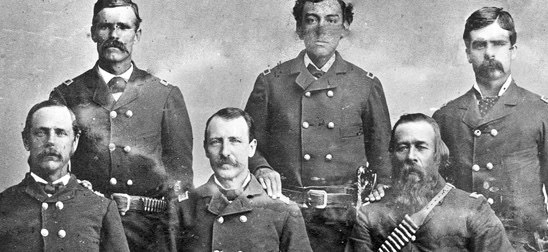
The attribution of this photograph of Albert Fountain (left) is not known. The photograph of Fountain and members of the New Mexico Volunteers - 1865 (left) is part of the NMSU Library Collection.
Churches, Preachers, and Priests
Where there is gold and silver there are preachers and priests. Out of the disorder which is associated with a mining community following the discovery of something valuable and mineable, preachers, priests, lawyers, judges, sheriffs and their deputies, and barbers try to establish order. All to often we think of mining communities as nothing more than a bunch of grubstake miners shooting, stealing, drinking, and making brothels profitable. There is certainly some (sometimes a great deal) of that, but there is also the story of Archibald Bishop Latham who was born in Texas in 1872. When he was 24 he married Nellie Laura Lee at Preacher J. T. Clark’s home along Tierra Blanca Creek. The two of them had three children; Archie, Thomas Jefferson (b. 1901 d. 1923), and Frederick. Both the senior Archibald Latham and his son Thomas Jefferson Latham are buried at the Lake Valley Cemetery. A complete registry of the cemetery is available. The Lathams were involved in the range war which pitted big cattle ranches (their side) against homesteaders. On more than one occasion people who taught religion ended up on one side or the other of the conflicts which were a part of this country
Many mining communities continued, in some fashion, even after the ore ran out. Some ceased to exist as quickly as they had been created. In the case of Lake Valley, some ore remained for quite a long time (manganese was mined in the area during the First and Second World Wars). Because of that and wide-spread ranching the town’s existence was prolonged well into the 1900’s. Steinsick (see below) notes that “Lake Valley, the former stage stop, with 12 saloons, three churches, two newspapers, a school, stores, hotels, stamp mills and smelters’ closed their post office in 1954 and the last resident left town in 1994.”
Thomas Harwood, in “History of New Mexico Spanish and English Missions of the Methodist Episcopal Church From 1850 to 1910” notes (p. 45) that “Hillsboro, Lake Valley and Kingston...these are mining towns, each in the center of its district, and we think they are here to stay. During the last year Brother Harwood formed these towns into a mission, and put in charge J. W. Hardenbrook, who preached until a few months ago, when he resigned.” He also reported the following extract from a report of 1886: “Kingston has, during the year, enjoyed a great boom in silver mining, over $300,000 having been taken from one mine within six months, it has a population of about 1,200; Hillsboro, 200 and Lake Valley, 250, and not a preacher of the gospel living in the county.” (p. 59) Around 1886 N. W. Chase was the Methodist Preacher in Kingston, his circuit included both Hillsboro and Lake Valley.
The New Mexico Conference United Methodist Historical Journal, Volume 2, has an article by Rev. Willard Steinsick written in 2008 entitled “The English Work of the MEC in Hillsboro, Lake Valley, & Kingston” which is well worth reading although it is focused heavily on Kingston.
The Saint Columba Chapel, Episcopal Chapel, was originally built as a small home. This was one of the stops of “Preacher” Lewis. In the last part (7:50-9:25) of an interview with Daisy Wilson she describes her memories of the Chapel and Lewis.
Fire
Starting in 1893 Lake Valley fell on a different type of hard times. Different from the everyday shootings, robbings, and general mayhem. 1893 saw the collapse of the price of silver and its various support mechanisms (subsidies). Two years later most of the town burned. The story, and in Lake Valley there were lots of stories, is that a Mr. Abernathy who was patronizing William Cotton’s saloon set the place on fire. Dry desert air turns wood into kindling and Lake Valley was built of wood and had been subjected to humidity in the single digits and a strong desert wind since it was established. Fire in that situation can be devastating, and it was. Without a demand for silver there was no reason to rebuild the town.
Chihuahuaita
A sign to the west of Lake Valley indicates the area (Chihuahuaita) where the Hispanic population of Lake Valley lived. Chihuahuaita is a fairly common name for Hispanic villages in the region, especially those which have some association with northern Mexico. Not all of the communities named Chihuahuaita vanished and the neighborhoods in Roswell and El Paso are still vital. Hispanics were widely discriminated against in the southwest and in hard times they suffered first and the most.
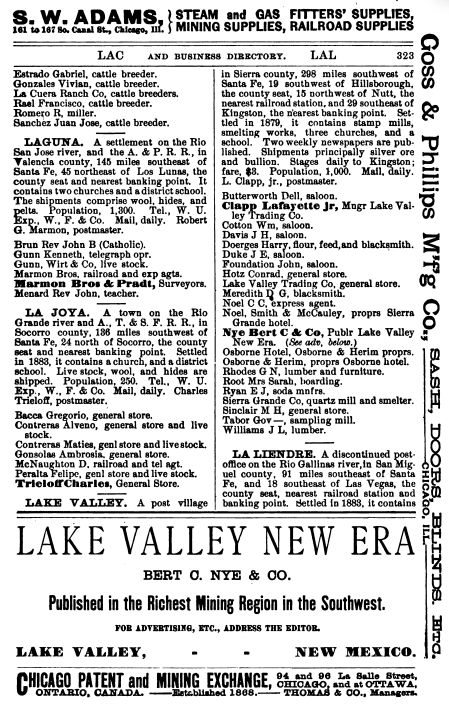
Lake Valley - 1884
The “Colorado, New Mexico, Utah, Nevada, Wyoming, and Arizona Gazetteer and Business Directory 1884-1885” described Lake Valley as (see left from page 323).
What Stands Today
The United States Bureau of Land Management (BLM) administers the Lake Valley site. They have published a small pamphlet entitled Lake Valley on its history. The “modern” photographs are shown in the photo galleries.
Be sure to stop at the exhibits maintained by the Bureau of Land Management in the old schoolhouse at Lake Valley.
During the first and second World Wars, manganese was mined at Lake Valley. The operations of the manganese mine are visible to the north of town.
Near Lake Valley
Lake Valley is located about half way between Nutt and Hillsboro along New Mexico Highway 27. Visit our auto tour route of Highway 27 for more information about the immediate area.
At the northern end of Highway 27 is the old mining town of Hillsboro. Visit our Hillsboro and Hillsboro Walking Tour pages for more information about that community.
The Geronimo Springs Museum in Truth or Consequences maintains several exhibits pertinent to this area.
The Deming Luna Mimbres Museum in Deming, the Black Range Museum in Hillsboro, and the Percha Bank Museum in Kingston all maintain exhibits on the history of the area.